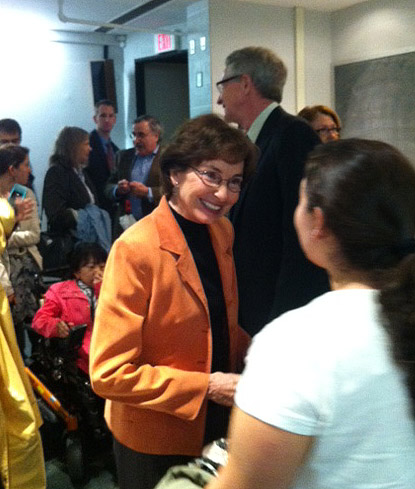‘Right to Die’ Debate Comes to BUSPH — and to Nov. 6 Massachusetts Ballot.
As a proponent of a Massachusetts ballot measure that would allow terminally ill patients to request a physician-assisted death, Dr. Marcia Angell has fielded opposition from the Catholic Church, some disability rights groups, and the Massachusetts Medical Society.
But with a month to go before Massachusetts voters weigh-in on Question 2, she worries about an even tougher opponent: “Ignorance.”
“People don’t know about it. They aren’t educated about it,” Angell explained at an Oct. 10 public health forum, at which she discussed the ballot measure. “[The concern is], people will just see the word ‘death’ and vote ‘no.'”
 Dr. Marcia Angell greets students after her forum presentation (Photo: Lisa Chedekel)Angell, former editor-in-chief of the New England Journal of Medicine and a senior lecturer at Harvard Medical School, said the ballot initiative is intended as a move toward patient autonomy, not as a substitute for good palliative care. The measure would allow terminally ill patients with a life expectancy of less than six months to request that a physician prescribe them barbiturates to end their lives.
Dr. Marcia Angell greets students after her forum presentation (Photo: Lisa Chedekel)Angell, former editor-in-chief of the New England Journal of Medicine and a senior lecturer at Harvard Medical School, said the ballot initiative is intended as a move toward patient autonomy, not as a substitute for good palliative care. The measure would allow terminally ill patients with a life expectancy of less than six months to request that a physician prescribe them barbiturates to end their lives.
Patients would have to make two oral requests for the medication, separated by at least 15 days, as well as a written request, and would have their requests denied if a physician determines that a psychological condition, such as severe depression, is impairing their judgment. Individual physicians would retain the right to refuse the request.
“There are a host of safeguards,” Angell said.
The Massachusetts initiative is modeled after a 14-year-old Oregon law that “seems to have worked exactly as intended,” Angell said. The Oregon provision has accounted for fewer than 600 deaths since its inception — or roughly one in 500 of all deaths in the state. Most of the patients were suffering from late-stage cancer, with a clear prognosis; others had end-stage emphysema or ALS. Evidence suggests that patients who opted for assisted death had no higher incidence of depression than those who didn’t, Angell said.
Interestingly, about a third of all patients who were provided with the life-ending medication did not take it, Angell said. Instead, they kept it on hand for “peace of mind.” In that way, the provision of medication “can be seen as a kind of treatment of depression” because of the sense of control it offers some patients, she said. Most people who have opted to die under the Oregon law have done so in their homes, with family, rather than in a hospital setting, she added.
While Angell acknowledged ethical concerns about the law, she said its intent is to allow patients who are suffering from a fatal disease some control over “the timing and manner of an inevitable death.”
“Good palliative care is adequate for the vast majority of dying patients, but not for all,” she said. “Most pain can be eased, but other symptoms are harder to deal with,” such as loss of control of bodily functions, weakness, and negative side effects of drugs. “Even worse, for many patients, is the existential suffering. They know that the course is inexorably downhill, and they find it meaningless to soldier on.”
Besides Oregon, Washington state and Montana also permit assisted dying. Angell said passage of the law in Massachusetts — a heavily Catholic state — would “really send a message” about patients’ rights.
The Massachusetts Medical Society has publicly opposed the bill. The group’s president, Dr. Richard V. Aghababian, has called physician participation in assisted suicide “fundamentally at odds with our duty to be healers.”
At the public health forum, audience members asked Angell about various aspects of the law, with one palliative-care specialist questioning why the focus was on ending life, instead of expanding and improving end-of-life care in Massachusetts. Angell said she hoped that the measure would help to bring more attention and resources to palliative care, not less.
George Annas, professor and chair of the BUSPH Department of Health Law, Bioethics & Human Rights, which sponsored the forum, said the issue was complex, since it touched on issues such as suicide and physicians’ roles.
“It’s complicated. It’s very hard… because death in America is something we deal with very poorly,” Annas said.
submitted by: Lisa Chedekel
chedekel@bu.edu